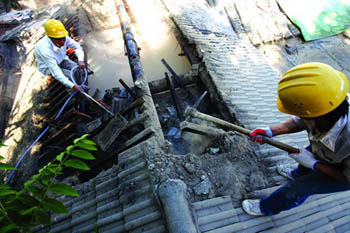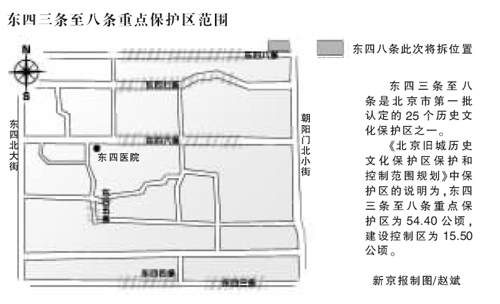| Tools: Save | Print | E-mail | Most Read |
| Ideological Showdown over Ancient Hutong Facing Demolition |
| Adjust font size: |
The Beijing Cultural Heritage Administration has called on city departments to halt the destruction of Dongsi Batiao, an ancient Beiing hutong, scheduled to be bulldozed for property development with demolition planned to begin on Monday. As D-Day rolled around, only one property suffered with six workers from Zhong Bao Jia Ye Property Development removing the roof, doors and windows off No. 9 courtyard in the hutong at around 8:30 AM, after initially being turned back the previous evening by protestors. As many residents gathered to watch the demolition, reactions seemed mixed.
Workers from Zhong Bao Jia Ye Property Development removing the roof, doors and windows off No. 9 courtyard in the hutong at around 8:30 AM. (Source: The Beijing News) One Batiao resident revealed that the compensation price had been fixed at around 8,000 yuan per square meter, a price which angered most residents, although some seemed amenable to moving should the compensation be upped. Huang, another resident, interjected that: "Many houses in this hutong are too old and do not make for convenient living conditions. We are willing to move if we receive satisfactory compensation." One woman, watching on in horror, repeatedly hit her face with her own hands, screaming at the workers: "You are demolishing During an interview with the Beijing Times, a staff member from the Beijing Municipal Administration of Cultural Heritage said that the office had written to the real estate developer, reminding them of the protected status of buildings in the alley. However, the administration does not have final say in these matters, meaning the hutong could still be torn down. Batiao hutong, located in the Dongcheng District of the capital, was first built around 700 years ago in the Yuan Dynasty and was deemed under cultural protection in 1999. According to the paper, the Dongcheng District housing administration published an announcement back in February that told of the hutong's planned demolition to allow the construction of an 80,000-square-meter six-floor residential building between Batiao and nearby Jiutiao. With the project possibly bringing as much of 190 million yuan (US$23.75million) in net profit, a second notice went up on April 15, telling residents to be out by May 26. Other instances of such notices came in 2000 and 2001 when the hutong was twice threatened with demolition but nothing came of it with only a government office and a charity factory relocating after receiving compensation. Liu Qifei, an archaeologist and a member of the CPPCC’s Beijing Committee also appealed to the municipal government in late April, to stop the project and to take action against the departments that initiated such a move. Liu decried that such a move would further tarnish On May 14, a government official, tasked with being an intermediary between residents and the developer, argued that the delays could be blamed on always-shifting policies and on the delay experts had asked for to assess which buildings in the protected area should be preserved or could be destroyed. In his discourse, the official specifically named two famed experts, Luo Zhewen and Zheng Xiaoxie, as having been consulted but these two later denied any involvement with the case, raising serious doubts about Zhong Bao Jia Ye’s methods. The dispute over which government department has jurisdiction over the preservation or demolition of Batiao remained unresolved, despite the intervention of relic expert and Director of the Chinese Society of Cultural Relics, Xu Pingfang. Xu explained that two types of area existed in the Batiao hutong area. Firstly, the main protected area covered the majority of land, spreading to 54.40 hectares with the other 15.50 hectares labeled in controlled area, including the number 9 courtyard whose demolishing started on Monday morning.
The shaded part at the upper-right corner shows the location of the No. 9 courtyard, a controlled area next to the ancient Batiao Hutong to the south. (Source: The Beijing News) Giving a wider overview, Xu seemed to buoy the hopes of the property development company in revealing that the Seeking perhaps to regain control of the story and to clear up any misunderstandings, Dongcheng District Housing Administration, Zhong Bao Jia Ye and the local cultural heritage administration held a joint press conference yesterday. During the conference, Zhong Bao Jia Ye's Deputy General Manager, Bai Hua, said that expert opinion had been divided on the fate of the hutong with some advocating its preservation with others giving the green light to the bulldozers to roll in. Bai confirmed that so far demolition work had so far only been confined to the controlled part, he hoped to secure building rights in the controlled area upon acquiring the land at auction. Bai also sought to reveal that his company’s move had engendered at least a modicum of public support, citing that 10 households out of Meanwhile, the fight to save one hutong continues and may become emblematic of an ongoing struggle to save Beijing’s old charm without which the city’s star would forever shine less brightly.
(China.org.cn by Chris Dalby and Wang Zhiyong, May 15, 2007) |
| Tools: Save | Print | E-mail | Most Read |
 |
| Related Stories |
|
Product Directory China Search |
Country Search Hot Buys |

